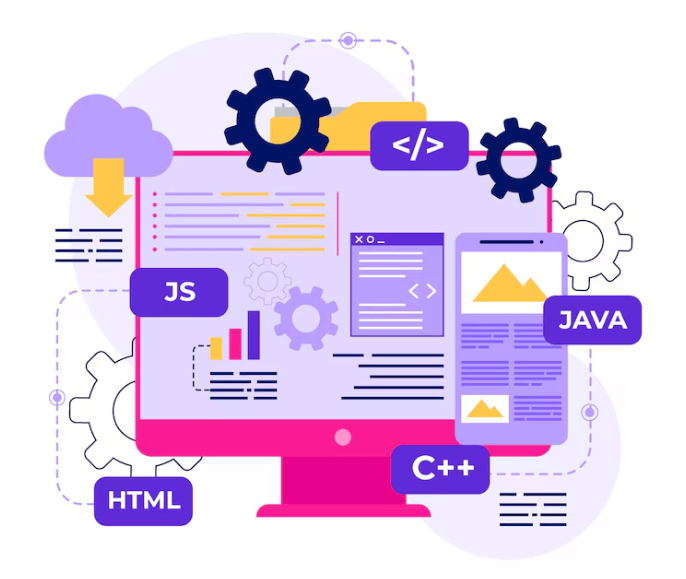Introduction

What Are Low-Code/No-Code Platforms?
Low-code and no-code platforms are tools that allow users to build applications through visual interfaces, using drag-and-drop components, pre-built templates, and simplified coding. The primary difference between the two is that no-code platforms do not require any coding skills at all, while low-code platforms may still require some basic understanding of programming to enhance the app’s functionality.
These platforms enable businesses to create custom applications, automate workflows, and design solutions that are tailored to their specific needs, all without the traditional complexity of software development.
How Low-Code/No-Code Platforms are Shaping the Future of Software Services
As technology continues to evolve, low-code/no-code platforms are becoming an integral part of the software services landscape. Here’s how they are driving the future:
1. Empowering Non-Technical Users
In the past, developing software required specialized knowledge of programming languages and development frameworks. Low-code and no-code platforms are democratizing development by empowering non-technical users to build their own solutions. This shift is opening up opportunities for departments like marketing, sales, and HR to create apps without relying on IT teams or expensive third-party developers.
For businesses, this means faster innovation and the ability to respond more quickly to changing needs. Companies can now prototype new ideas, test solutions, and implement changes much more swiftly, giving them a competitive edge in a fast-paced market.
2. Accelerating Time to Market
Time is money in business, and low-code/no-code platforms significantly reduce the time required to build and deploy applications. Traditional development can take months, but with these platforms, a custom app can be developed in a matter of weeks—or even days. This accelerated development cycle enables businesses to bring products to market faster, respond to customer needs more promptly, and stay ahead of competitors.
This rapid time to market is particularly beneficial for industries where agility is crucial, such as retail, finance, and healthcare, where customer expectations are constantly shifting.
3. Reducing Development Costs
Developing custom software solutions from scratch can be expensive, especially when factoring in the cost of hiring skilled developers and maintaining the software over time. Low-code and no-code platforms drastically reduce these costs by eliminating the need for specialized programming knowledge and reducing reliance on external developers.
Businesses can save on development costs, allocate resources to other strategic initiatives, and create solutions that are cost-effective in the long term. Moreover, these platforms often come with built-in templates and features that reduce the amount of coding and customization required.
4. Improving Collaboration Between IT and Business Teams
Low-code/no-code platforms encourage collaboration between IT and business departments. While IT teams still play a key role in ensuring security, scalability, and compliance, business teams can take the lead in creating and refining applications. This collaboration results in more practical and efficient solutions that meet the actual needs of the business.
For example, a marketing team can use a no-code platform to create a customer feedback app that integrates with their CRM system. Meanwhile, IT can ensure that the app aligns with company security standards, enhancing both functionality and compliance.
5. Enabling Continuous Innovation
The low-code/no-code trend is pushing businesses to continuously innovate by providing them with the tools to build and modify software as they go. With the ability to create applications rapidly and iteratively, companies can launch MVPs (Minimum Viable Products), test them with users, gather feedback, and improve on them in real time.
This continuous loop of development and feedback fosters a culture of innovation, where businesses can quickly pivot and refine their offerings based on user input, market trends, and internal requirements.
Key Benefits of Low-Code/No-Code Platforms for Software Services

1. User-Friendly Interface
Both low-code and no-code platforms are designed with user-friendliness in mind. They use visual interfaces with drag-and-drop functionality that makes building applications accessible to users with no programming background. This ease of use empowers a wider range of people within an organization to get involved in application development, making it a highly collaborative process.
2. Scalability and Flexibility
While initially designed for smaller applications or prototypes, many low-code/no-code platforms now offer enterprise-level scalability. Businesses can create complex apps that meet specific needs and scale them as their requirements grow. This flexibility ensures that companies can evolve their software as they expand, without the need for complete redevelopment.
3. Integration with Existing Systems
One of the main challenges in software development is ensuring that new applications integrate seamlessly with existing systems. Many low-code/no-code platforms come with built-in connectors and APIs that make it easy to integrate with popular CRM, ERP, and cloud-based applications, eliminating the need for custom development.
4. Security and Compliance
With the growing concern over data privacy and security, low-code/no-code platforms are increasingly focusing on security features. Many offer built-in security protocols, encryption, and compliance options to ensure that applications meet industry standards, protecting sensitive data from potential breaches.
Challenges to Consider

While low-code/no-code platforms offer numerous benefits, they are not without their challenges. Businesses must still ensure that applications are secure, scalable, and aligned with their long-term goals. For complex, high-performance applications, traditional development methods may still be necessary. Additionally, managing the proliferation of custom-built apps across an organization can require additional governance to ensure consistency and compliance.
Conclusion
The future of software services is undoubtedly tied to the continued growth of low-code and no-code platforms. These platforms are making application development faster, more accessible, and more affordable than ever before, while enabling businesses to innovate and collaborate like never before. As the demand for custom software solutions grows, low-code/no-code platforms will become an essential tool for businesses seeking to stay competitive in an increasingly digital world.
For businesses looking to harness the power of low-code/no-code platforms, partnering with a reliable software services provider can ensure the development of secure, scalable, and innovative solutions tailored to meet specific business needs.







